Space balloons, mousetraps and earthquakes: it’s Science on Stage! Inspire article
Science on Stage and the European Science Teaching Awards 2005: choosing the best of the best, special mentions and how the jury voted. Myc Riggulsford, UK science broadcaster and journalist, and Barbara Warmbein, from the European Space Agency in Noordwijk, the Netherlands, describe how the…
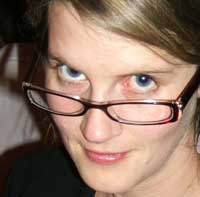
Mad, scruffy, elegant, shock-haired and awesome, Europe’s best science teachers were at CERN in Geneva, Switzerland, in November 2005 to celebrate the best of the best in physics, chemistry, biology, mathematics and general science teaching.
Well, ‘scruffy’ is a bit unfair, as the Swedish delegation turned out in full evening dress despite the freezing marquee and snow outside, to sing songs and make ice-cream in the Nobel Prize Junior project, demonstrating their dynamic approach to making science fun. And fun it was. Not to mention the excitement of €17 000 in prizes in the final celebration of Science on Stage.
So just how does a jury decide which top-class projects are worthy of even further praise and prizes, when each one has somehow inspired schoolchildren to find science exciting?
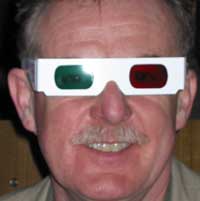
The jury was drawn from a wide range of backgrounds: Eleanor Hayes, editor of Science in School; Henri Boffin from the European Southern Observatory; Chris Warrick of the European Fusion Development Agreement; and Fernand Wagner, president of the European Association for Astronomy Education and a practising physics teacher.
And us: Barbara Warmbein, editor at the European Space Agency, and Myc Riggulsford, a science broadcaster and journalist who presented the Science on Stage festival highlight sessions, a brand new idea for this year’s festival which singled out some of the best projects and put them on stage.
The jury looked for teaching excellence, inspiration and motivation of young people. The European Science Teaching Awards are backed by the European Commission and the EIROforum, a collaboration of international science facilities, with prizes to help make outstanding methods and models available to other European colleagues. Science on Stage was run in 29 countries, involved thousands of science teachers from around Europe, and finished with over 500 of the national winners representing their countries at the world’s largest atom-smashing facility: CERN in Switzerland.
But with every single project in the science fair so excellent and inspiring, it made the judges’ jobs tremendously difficult. We decided that we would look for extra special criteria – such as a project which inspired girls to take an interest in the traditionally male ‘hard’ sciences. Such as the Danish project in which recycled copper wire was stripped and turned into silver-plated jewellery, making Nanna Kristensen’s idea so simple yet brilliant.
We wanted projects which crossed curriculum boundaries, which could be repeated elsewhere by other teachers, and which could be used in any type of school. And we wanted new ways of thinking and reaching out about science.
For too long, too many physics teachers have had mental walls around their laboratories, so it was a delight to find UK school librarian Mandy Curtis and her display of cross-curricular activities to celebrate Einstein Year, underlining the lesson that many more non-science students can be reached with the right approach outside the lab. In a similar spirit, Italian science teacher Gianluca Farusi used an exquisite Piero della Francesca painting to demonstrate the chemistry of pigment extraction and the physics of forensic painting analyses, see Teaching science and humanities: an interdisciplinary approach in this issue of Science in School.
We also realised that some schools have access to more money and resources than others, and so we looked particularly at projects from the former Eastern bloc, those which made the best use of scarce materials, and those which cheaply demonstrated important scientific principles or had special relevance through explaining a difficult concept in a simple way. We found stands full of miniature volcanoes, impact craters, magnets, circuit boards, candles and electrostatic wigs. And teachers who presented the experiments with so much enthusiasm that you just had to stay and watch.
In the category ‘cheap but successful’, Tobias Kirschbaum’s models from Germany were outstanding. He had set problems for his students to work out how an ancient Chinese seismograph worked, so they designed a model which drops a marble from a dragon’s mouth, showing the direction from which an earthquake came. They then used bicycle spokes and elastic to demonstrate wave propagation. See Tracing earthquakes: seismology in the classroom in this issue of Science in School.
In an extraordinary combination of recycling, art and biology, Greece’s Evanthia Papanikolau made a wonderful DNA helix from plastic drinks bottles, strung together by their lids, which was not only in proportion to the size of the biological components, but allowed cell division and DNA replication to be demonstrated by simply unscrewing the bottles and matching each half with new ones.
We could not decide on our best definition for innovation – were we looking for new ways of teaching old science, old ways of teaching new science, or a radical approach to the latest developments? In the end, we tried to look for all these things. From Portugal, we found Maria Matos and Maria Carvalho, who used reference fungus and lichen collections not only to identify the different species they found on field trips, but also as a cheap and simple way of measuring air and water pollution, showing that old taxonomic skills have new relevance today.
There was no prize category for team effort, a country, stand or group of exhibits, or perhaps the Swedish group would have won an award for their daily themed exhibits – arriving one day in full evening dress, another in space gear. We were looking for individual experiments, a special teacher to single out.
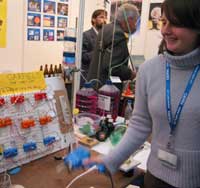
demonstrates a model of the
nervous system
Some experiments came as an exciting themed package, such as the bombs, rockets and other action models of Eilish McLoughlin and colleagues from Ireland. Similarly, we were impressed by Wim Peeters from Belgium, whose box of experiments, called ‘Physics is Cool’, could be used in any school, narrowly beating other similar projects such as Giorgio Häusermann’s Swiss version called ‘Einstein’s Box’.
In amongst the physicists, we also found biologists with new ways of explaining the functions of the human body, sometimes using several science disciplines. We liked the working model of a heart made by Dimitris Zamagias from Greece, but in the end we awarded the prize to Hungary’s Agota Lang for her nerve model, ‘Garfield the Lazy Cat’, and to Jerzy Jarosz and Aneta Szczygielska for their outstanding full-size body showing the workings of the cardiovascular system, at the Polish stand.
Our greatest asset as judges were the science teachers themselves, as sometimes we simply followed the crowds to see what fascinated them, and which experiments they liked best. And if we had a prize for sheer vivacity, enthusiasm and downright danger, then surely it would have gone to the whole Spanish delegation, whose constant energy – on stage and off – kept everyone enthralled. And nearly lost Myc his eyebrows.
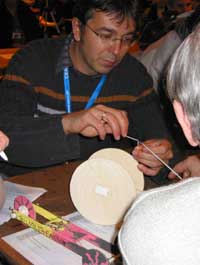
and runs
Unfortunately, we could not award prizes to everyone, so we had to leave out Michael Sach from Germany, with his students’ mousetrap-powered racing cars, Cypriot software designer Alberto Florentin’s computer-based teaching tool, and the simple Romanian model eyeball made from a shampoo bottle. And if we had given a prize for the most effective but least high-tech project, it surely would have gone to Hungary for the simple trick of a sheet of paper and a piece of wood to demonstrate air pressure and resistance.
Finally, the experiment which most summed up the spirit of Science on Stage, and which we rewarded with the top prize of €4000, was Catherine Garcia-Maisonnier’s weather balloon, with its gondolas designed, built and equipped by her French schoolchildren. They patiently worked out what they wanted to measure and how they wanted to measure it, throwing out the impractical and the too heavy, to achieve an outstanding experiment which worked on many different levels, and reached a truly impressive height!
Well done everyone – without you, science and Europe would be a greyer place. We rely on you, the science teachers, to inspire the youngsters of today to become the scientists of the future, and you exceeded all our expectations. It was a pleasure working with you and seeing how much fun science has become – we just wish you had been around when we were at school.
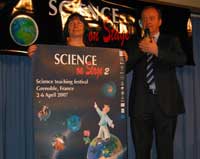
Stage 2 in 2007?
Now the only thing left to do is to tell the world. You can double the value of Science on Stage by forgetting your modesty and telling newspapers, radio and television about your success. Does your cousin work for the local paper? Is your neighbour a journalist? Go out and tell people, and inspire your colleagues and schoolkids, so that the cliché of boring science lessons becomes just as antiquated as the cliché of mad scientists that you all proved wrong during Science on Stage.
Science on Stage is not about prizes and winning – it’s about exchange and inspiration. But the European Science Teaching Awards are part of the fun; they are something to show at home, a recognition of your effort. If you didn’t receive a prize this year, try again at Science on Stage 2, which will take place in Grenoble, France, from 2-6 April 2007. Get involved in your national event now – all details are on the Science on Stage website.






